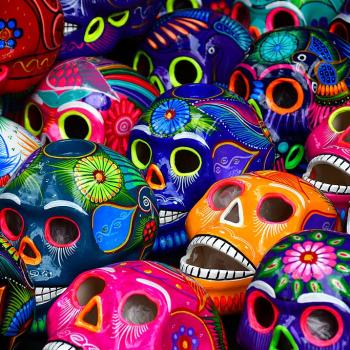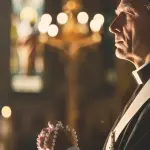KEEP THE ASPIDISTRA FLYING: (edited to add links, itals, and tags, but nothing else) OK, as promised, a reply to John Corvino. It’s long so it will be broken into two posts. In this post, a tiny bit on biological relatedness, and a really long bit on iconography; in the next post, sexual regulation.
First, I feel very silly. I’d actually read the column on biological fatherhood which Corvino wrote earlier, and to which he links in his reply, and I wish I’d reread it before writing my post. I truly don’t think he can separate the case for gay marriage from the case against honoring biological ties (or the case for donor conception) as cleanly as he’d like to, but that’s a complex argument which I’m not entirely sure how to articulate right now. One philosophical claim is that I’m not sure why heterosexual couples get to be really important and interesting in—to use Catholic jargon—their procreative function, but remain banal and Just One Kind of Couple Among Others in their unitive function. One claim about rhetoric is that I’ve very frequently been told that gay marriage is great because how dare you say adoptive families, or stepfamilies, or single parents who make sure their kids have “male role models,” are missing anything at all? …But I should say that the previous sentence could easily be turned back on me, since I hate so much of the rhetoric deployed against gay marriage.
And the more important point for this specific discussion is that I should have engaged with Corvino’s actual position, and not what I projected on to him. That was ridiculously sloppy and gross, and I truly apologize for it. You should read his column and think about how we can honor both biological ties and families formed in other ways, since that’s the question he’s grappling with and it’s obviously an important one.
Now, Corvino to me on sex difference as iconic rather than practical or contingent:
It’s hard to respond to that, except to note that it depends on a radically different worldview from mine: As I see it, of the many important purposes of marriage, iconography is pretty low on the list.
I value marriage because of the concrete ways in which it recognizes and fortifies families, helping them to sustain relationships that do them—and society—palpable good. It serves people’s deep needs for intimacy, care, support in childrearing, and
so on. Gay and lesbian people have those needs, too.So if it’s a choice between marriage-as-iconography and marriage-as-meeting-concrete-needs, I’d pick the latter every time.
I think we’re talking past each other here a bit. Let me first state what I think iconography does for society, then why I think the primary benefits of marriage are often due to its iconographic rather than practical nature, and then how this relates to marriage as the union of man and woman.
Iconography is how a culture inspires its members to meet common goals without using the police power. Iconography is how a culture gets its members to long to do the right thing, rather than coercing them into obeying the laws. (Thus the iconographic nature of marriage actually skyrockets in importance when forced marriage is outlawed and legal penalties for premarital or extramarital sex are rescinded.)
There is no government in which iconography does not play a major role. How articulate a culture is about its own iconography, and the content of that iconography, determines (this is just off the top of my head, and only counting stuff where government gets involved): what is taught in public schools, where conscientious objection is allowed and where it is not, what is a religion and what is a scam, what is charity and what is politics, how people describe their desire for public service or military service, and what’s in the national anthem.
A quick interlude: I’m in the middle of Paul W. Kahn’s Putting Liberalism in Its Place. Kahn, himself apparently a liberal, is nonetheless concerned with mapping the limits of liberal philosophy and the “here there be dragons” areas outside those limits. His basic thesis is that liberalism thinks in the categories of reason/discourse and desire (/choice/self-expression), but is baffled by the categories of honor, sacrifice, and love/personal loyalty.
And my claim here is that social order, rule-utilitarian maximization of happiness, reason (which IMO in the liberal mind gets defined instrumentally, as “the thing which helps us get to rule-utilitarianism,” when they bother to define it at all rather than simply relying on how they were raised and saying that that’s reasonable and everyone else is crazy), and choice are not the only goals toward which a government may orient itself. In fact, with Kahn, I’d argue that no government in the history of ever has actually oriented itself only around these goals, without incorporating notions of beauty, sublimity, nature, honor, and similarly illiberal things.
(I should note that I have at least one huge problem with Kahn so far, but I’ll get to that when I’ve finished the book!)
I wonder if one way to put why Corvino and I haven’t yet “achieved disagreement” on this issue is the following: I believe that there are no fully secular arguments. I believe that eventually we hit rock bottom and you have to start talking in terms of whom or Whom you love, and what you believe to be the facts about human nature which we shouldn’t change even if we can, even if they hurt. And these claims about love and nature are, if not entirely or explicitly religious, still very, very close to religion. Yet a pluralist society rightly seeks to postpone hitting this rock bottom as long as possible, and often, rightly, recuses itself from judging between competing systems of love and nature.
But I think that because it is so universally attested, in the law and liturgy and art and popular culture of societies with such a vastly divergent array of religious beliefs, the iconic status of sex difference is not sectarian and lies several steps above the rock bottom. My impression, which could be entirely wrong, is that Corvino sees this iconographic claim as on the rock bottom, where a pluralist society ought not descend, or at best a half-step above it.
Okay, but why is marriage an important arena for iconography?
My beliefs here are strongly influenced by my work at the pregnancy center. The women there so often long for marriage with a poignancy I can barely describe. They do not expect practical benefits to outweigh practical drawbacks. The practical benefits provided by (occasionally) slightly greater social support are counterbalanced by the threat that they will lose their government aid, and that they will find it much harder to leave a man who becomes abusive, addicted, incarcerated, or otherwise unacceptable. The benefits of marriage are, for them, primarily about what it will do for their sense of self, which is a result of its iconographic power.
And also, my beliefs here are strongly influenced by, like, being gay. Gay couples long for marriage not solely—and often not primarily, as the rejection of civil unions suggests—for the practical benefits. I do not mean in any way to denigrate the importance of e.g. being able to make medical decisions for an incapacitated partner. The practical benefits are real. But the benefits I talked about in my “Home and Dry” post, of home and honor, are entirely a result of marriage’s iconic status. And I think that these benefits lie close to the heart of the push for gay marriage rather than alternative kinship forms. (The other reason for “gay marriage, not alternative kinship forms” is that modern folk, to our great detriment, stripped away the social and legal recognition and honor which once accrued to forms of kinship such as friendship and godparenthood. This is bad. Because we can only understand kinship in terms of marriage and parenthood, we can only understand gay relationships as either marriages, or not really kin at all. This is the false dichotomy Corvino should be attacking!)
Okay, but so, marriage is really important, people long for it, I get that. What does that have to do with sex difference?
Let me throw out three thoughts here. 1. What’s past is prologue. Even societies which found ways of honoring some forms of homosexual relationships have not considered those relationships interchangeable with marriage, or a form of marriage, until very recently. This means that 99 44/100ths of our marital iconography is geared toward the needs and desires and images of heterosexual couples. I think for anyone with even a smattering of Hayekian humility in the face of the past, this overwhelming persistence of heterosexual marital imagery should give pause.
2.I complained here about Julia Kristeva’s attempt to separate “biological” from “biographical” life. But I think she’s gesturing toward or elaborating on a real insight: The stories we tell about our biology can deeply affect how we use our bodies. Therefore if we misunderstand which aspects of our bodily differences are iconic and which are merely necessary, we will very likely misunderstand how we should respond to those differences, how we should act in our bodies. So, since I already believe that sex difference is iconic in a way which very few other differences could ever approach, for all the reasons I gave in the links in that last post… it’s important to me that we get the iconography right.
3.I don’t want to instrumentalize beauty or sublimity. I believe that the practical, biological differences between men and women are, in themselves, largely responsible for the nature and importance of marriage. But the existence of this institution, which acknowledges and responds to la difference, is valuable in itself. As an analogy: The honor gay couples are seeking for their love, when they work for gay marriage, will produce practical benefits in terms of social support. But it’s also valuable in itself.
I think our basic job right now, as a society, is to find ways of honoring nonmarital kinship without conflating it with marriage. This is basically an iconographic task, and gay marriage works against it.











